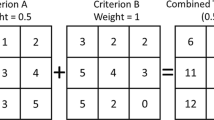Abstract
This paper studies subjective priorities for the data amounts in the processing of geopolitical data accoding to Mazis I. Th., theoretical paradigm of Systemic Geopolitical Analysis. After defining geopolitical plans and geopolitical focus sets, they are introduced geopolitical preferences and geopolitical management capacities. The geopolitical rational choice is studied, as well as the geopolitical preference-capacity distributions. Then, they are investigated geopolitical contrasts of subjective priorities by several geopolitical operators, and it is shown that there are cores and equilibriums of geopolitical contrasts, the study of which may provide useful information.
Similar content being viewed by others
Notes
A distribution \( \mu \) on \( {\mathbb{P}} \times {\mathbb{K}} \) is atomless if \( \mu \left( {{\mathfrak{X}}, \succ ,{\boldsymbol{\mathcal{C}}}_{{\boldsymbol{\mathcal{M}}}} } \right) = 0 \) for every \( \left( {{\mathfrak{X}}, \succ ,{\boldsymbol{\mathcal{C}}}_{{\boldsymbol{\mathcal{M}}}} } \right) \in {\mathcal{P}} \times {\mathbb{R}} \).
\( {\mathcal{B}}\left( M \right) \) denotes the Borel \( \sigma\)-algebra generated by the open subsets of \( M \).
If \( M \) is a metric space, \( f \) is a measurable mapping of \( {{\Omega }} \) into \( M \) and \( h \) is a measurable mapping of \( M \) into \( {\mathbb{K}} \), then \( h \) is \( m \circ f^{ - 1}\)-integrable if and only if \( h \circ f \) is \( m\)-integrable and \( \int_{M} {h\,dm} = \int_{{{\Omega }}} {h \circ f\,dm} \).
A relation \( \varphi \) of the metric space \( {\rm M} \) into the metric space \( {\rm N} \) is said to be upper hemi-continuous at \( x \in {\rm M} \) if \( \varphi \left( x \right){ \not\equiv }\varphi \) and if for every neighborhood \( U_{\varphi \left( x \right)} \) of \( \varphi \left( x \right) \) there exists a neighborhood \( U_{x} \) of \( x \) such that \( \varphi \left( {U_{x} } \right) \, \subset \, U_{\varphi \left( x \right)} \). A relation \( \psi \) of the metric space \( {\rm M} \) into the metric space \( {\rm N} \) is said to be lower hemi-continuous at \( x \in {\rm M} \) if \( \psi \left( x \right){ \not\equiv }\psi \) and if for every open set \( G \) in \( {\rm N} \) with \( \psi \left( x \right) \, \bigcap \, G \ne \psi \) there exists a neighborhood \( U_{x} \) of \( x \) such that \( \psi \left( {U_{x} } \right) \, \bigcap \, G \ne \psi \).
References
Aron, R. (1967). Qu’est-ce qu’une théorie des relations internationales? Revue française de science politique, 17, 837–861.
Daras, N. J., & Mazis, J. Th. (2014). Geopolitical systemic modeling: Part 1 prediction of geopolitical events. GeoJournal, Spatially Integrated Social Sciences and Humanities, 79(4). doi:10.1007/s10708-014-9569-3.
Devetak, R., Burke, A., & George, J. (Eds.). (2007). An introduction to international relations (2nd ed.). Cambridge: Cambridge University Press.
Lakatos, Ι. (1970). Falsification and the methodology of scientific research program. In I. Lakatos & A. Musgrave (Eds.), Criticism and the growth of knowledge (pp. 91–196). Cambridge: Cambridge University Press. (Digit. Print 2004).
Mazis, I. Th. (2001). Geopolitics of water in the Middle East: Arab countries-Israel-Turkey (in Greek, 440 pp). Athens, 1996: Trohalia Publishing.
Mazis, I. Th. (2013). L’Analyse géopolitique systémique: Propositions terminologiques et définitions métathéoriques selon l’exigence métathéorique lakatienne. Géographies, Géopolitiques et Géostratégies Régionales, 1(1), 21–32.
Mazis, I. Th. (2015a). L’Analyse géopolitique systémique: Propositions terminologiques et définitions métathéoriques selon l’exigence métathéorique lakatienne. Dissertationes Academicae Geopoliticae, éditions Papazissi, Athens, pp. 1043–1062.
Mazis I. Th. (2015b). Methodology for systemic geopolitical analysis according to the Lakatosian model. Dissertationes Academicae Geopoliticae, éditions Papazissi, Athens, pp. 1063–1072.
Meyer, P. A. (1966). Probability and potentials. Waltham: Blaisdell Publishing Company.
Toncea, V. (2006). Geopolitical evolution of borders in Danube Basin, Ph.D.
Author information
Authors and Affiliations
Corresponding author
Rights and permissions
About this article
Cite this article
Daras, N.J., Mazis, J.T. Systemic geopolitical modeling. Part 2: subjectivity in prediction of geopolitical events. GeoJournal 82, 81–108 (2017). https://doi.org/10.1007/s10708-015-9670-2
Published:
Issue Date:
DOI: https://doi.org/10.1007/s10708-015-9670-2
Keywords
- Systemic geopolitical analysis
- Geopolitical operator
- Numerical carrier of weighted geopolitical index
- Geopolitical plan
- Geopolitical focus set
- Geopolitical preference
- Geopolitical indifference
- Geopolitical significance
- Geopolitical management options
- Mean geopolitical rational choice
- Geopolitical preference distribution
- Geopolitical capacity distribution
- Geopolitical sector
- Geopolitical contrasting of subjective priorities
- Core of contrasting geopolitical subjective priorities
- Equilibrium of contrasting geopolitical subjective priorities
- Geopolitical equilibrium vectors




